“Do you know where to find marble conference tables? I'm looking to have a conference... not until I get the table though” -@kanyewest on Twitter
If you noticed we had a busier week than normal here at Starts With A Bang, you weren't alone. But there's a good reason: the first week in January marks/highlights the annual American Astronomical Society big meeting, and yours truly was not only in attendance, but I did my best to bring you the scoop on the biggest stories at the start of 2015! In addition to our regularly scheduled programming, we had a host of special articles. Altogether, we've taken a look at:
- Is our Universe escaping us? (for Ask Ethan),
- A science teacher's art challenge (for our Weekend Diversion),
- Genesis episode 4, Atoms (for Mini-Movie Monday),
- What do we expect of a space program?, (from AAS)
- The most amazing Hubble image ever, (from AAS)
- Why do galaxies have black eyes?, (from AAS)
- How many habitable planets are in our galaxy?, (from AAS)
- The status of the Universe: 2015, (from AAS) and
- The burden of proof (for Throwback Thursday).
That's a lot, of course, but that hasn't stopped you from having your say. Let's take a look at the best/most educational for your Comments of the Week!
Image credit: The Cosmic Perspective / Jeffrey O. Bennett, Megan O. Donahue, Nicholas Schneider and Mark Voit.
From Kevin Wallace on the future of our Universe: "In the image from the Cosmic Perspective, the curves leading up to the present are very different between the first two scenarios, the third, and the fourth. Is there are reason we couldn’t look at the rate of expansion of the universe in the past, and depending on whether the curve is logarithmic, linear, or exponential, make a logical deduction on its future course? I understand that dark energy is unpredictable, but given the past behavior and momentum going into the future, couldn’t we make a meaningful prediction going forward based on what we see?"
Kevin, not only is that a great idea, but that's exactly what we do and how we do it! You see, if you look at the Universe "now", which means if you look locally/nearby, it's very, very hard to tell which type of Universe we live in. It's only at great distances -- where the Universe has been expanding for literally billions of years since the light was emitted -- that we can begin to tell different cosmological models apart. When the Hubble space telescope was first proposed, its stated goal (and why it was named the Hubble telescope in the first place) was to measure the expansion rate of the Universe: the Hubble parameter.
After about 10 years, we did! We measured it to be 72 km/s/Mpc, with an uncertainty of about 10%, a phenomenal achievement. In addition, there was hope, but not necessarily great hope, that we would be able to measure how the expansion rate changed over time, something that would require not going out to a few hundred Megaparsecs (a parsec is ~3.26 light years), but to a few thousand.
Nevertheless, that's what the various supernova teams went out and found. As you can see, for the first 1 or 2 thousand Mpc, the different curves are very difficult to distinguish. In particular, an "empty" model and a "dark energy" model and a "dusty" model are all very hard to separate.
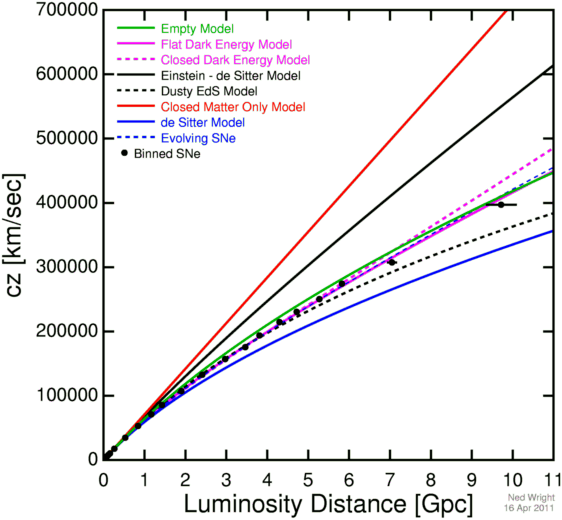 Image credit: Ned Wright, using data from Conley et al. (2011), via http://www.astro.ucla.edu/~wright/sne_cosmology.html.
Image credit: Ned Wright, using data from Conley et al. (2011), via http://www.astro.ucla.edu/~wright/sne_cosmology.html.
Still, the error bars have gotten smaller as our statistics have gotten better, and this is exactly why (and how) we've been able to determine that we do live in a Universe dominated by dark energy. Take a look at what happens to this graph -- with error bars -- if we subtract the "empty Universe" model from all the others.
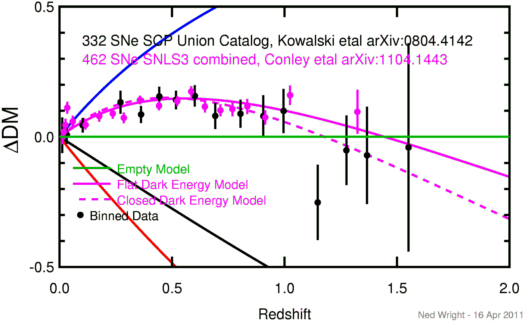 Image credit: Ned Wright, using data from Conley et al. (2011), via http://www.astro.ucla.edu/~wright/sne_cosmology.html.
Image credit: Ned Wright, using data from Conley et al. (2011), via http://www.astro.ucla.edu/~wright/sne_cosmology.html.
There is very clearly either dark energy or something very close to it. When the supernova data is combined with the cosmic microwave background and -- most recently -- the baryon acoustic oscillation data from large scale structure, we've found that we live in a Universe dominated by dark energy with an uncertainty on the equation of state (w = -1.00) of less than 10%. So Kevin, that is what we do, but we're limited by how accurately we can measure supernovae (and how many we can measure) at a redshift of say, 1.0 or higher. But we're getting there, and dark energy it is!
Image credit: me. In fact, this is an image I made for my book that I’m writing. Did you know I’m almost done writing a book?! More information soon!!
From Ciaran on the same post: "That must be the most low-key book announcement ever! Looking forward to it."
I posted the image above with the caption above on my blog last week, and I'm going to tell you all what the deal is: about two years ago, I got a call from a publisher -- World Scientific -- that noticed my blog and my writing, and asked if I ever thought about writing a book. I said yes, they said "about what?" and I told them.
I told them about how everyone deserves the full, up-to-date story of the Universe, regardless of their math and science capabilities and affinities. Sure, in an intro astronomy course, we all learn about naked eye observations, eclipses, the solar system, heliocentrism, gravity, and then about telescopes and the astronomical advances that come along with that. But that should be chapter one. And then we should give people the real deal: General Relativity, the expanding Universe, where the elements come from, the microwave background, the Big Bang, dark matter, dark energy, inflation, and why there's more matter than antimatter in the Universe. You know, all of it.
They said, "write it." I did. I'm finishing the final images, and I'll submit it later this month. You're all going to buy a copy when it's ready, and for those of you who teach (or took, or will take) intro astronomy, your life (and your students' lives) will never be the same, because they're about to get awesome.
From David Hurn on structure formation: "How important was the dark matter (or whatever is causing its effect) in forming the seeds for collapsing stars, or can this be caused by quantum fluctuations alone?"
So I make videos now (sometimes), and when you say "seeds," it depends on what you mean. The initial density fluctuations come from quantum fluctuations during inflation, no doubt. If that's a "seed" enough for you, you're good. But if you need your seed to say, germinate and grow, you'll need dark matter for that. Without it, the small scale structure -- for the first star clusters -- gets washed out! Take a look at the difference between the power spectrum, that is, a measure of how easy it is to form structure, on small scales both with and without dark matter.
Note how over towards the right, you need some amount of dark matter (CDM -- cold dark matter -- works best) in order to not suppress structure on small scales. Baryons alone lets it die due to oscillations/Silk damping. But if you throw a mix of dark matter and baryons in, the "CDM" dominates, and the baryons add just a little bit of "wiggling" to it.
You might wonder what we actually see, by the way.
So, yeah, dark matter is there, and it helps germinate the seeds, but doesn't form them on its own.
On the purpose of a space program, I really liked the comments of Joseph Karpinski and S Call, so they are reproduced (in full) below, with little further comment necessary.
Well, I think it’s time to change our model.
The LHC brought funding and partners from all over the world.
We need to change our U.S. only approach, and include others.
A real partnership with the ESA, as well as with India, China, Russia, Japan, UK, etc etc.
Share in the costs. Share in the achievements.
Leverage “Best of Breed” practices that industry has been using for years.
Most published scientific articles are group efforts, that in many cases contain contributions from others all over the world.
It’s time to change our approach to space exploration.
Start as a collaboration among friends.A prelude to the United States landing on the Moon was a bold vision articulated regarding that mission, its purpose and benefits. The purpose and benefits were visionary but readily understood by the citizenry. As an initial step to garnering enthusiasm and support for further, manned space exploration, a vision must again be articulated. Saying, “We want to land people on Mars,” is merely stating what the activity is, not stating what the purpose and benefits are, especially in the context of a well-articulated long term plan. Some people are very motivated and enthused simply by the idea; but other people require a richer articulation of why. This articulation should be well-rounded, including both practical and personal reasons of interest that appeal to more than just enthusiasts. If you are reading this, probably you have some off-the-cuff ideas, like I do. However, someone must craft an extraordinary version of this vision with its attendant appeals before the hominids on this planet, who once walked elsewhere than on Earth, again look up and think, more or less collectively, “Let’s go there!”
I would like to see us go. I would like to see space funding increase, for space science funding to increase, and for space exploration funding to increase. It's all valuable, and it's what we all got together at AAS to talk about, share in and pursue. And I know it's something you care about, too.
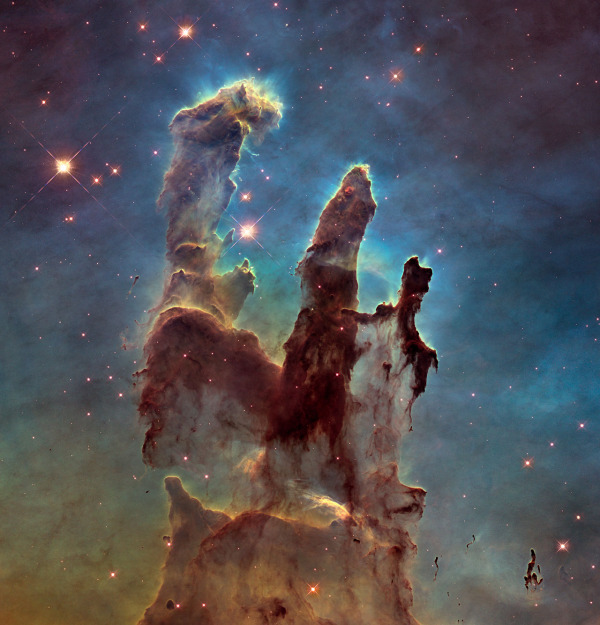 Image credit: NASA, ESA/Hubble and the Hubble Heritage Team; Acknowledgement: P. Scowen (Arizona State University, USA) and J. Hester (formerly of Arizona State University, USA).
Image credit: NASA, ESA/Hubble and the Hubble Heritage Team; Acknowledgement: P. Scowen (Arizona State University, USA) and J. Hester (formerly of Arizona State University, USA).
From MobiusKlein on the new Pillars of Creation image: "When I first read about the Hubble Deep Field imagery, I read up on how they combined the large number of exposures over time into a scientifically accurate image. How has the math and technique advanced since that time? What more information are we able to gather based on these advances?"
Well, for one, we know the rate of evaporation of the pillars, thanks to images that were presented (but are not publicly available) that show how the evaporation is taking place. You may have heard some state that "the pillars are already gone" since they would have been torn apart by supernovae, and it's 6,000 light years away.
Not true!
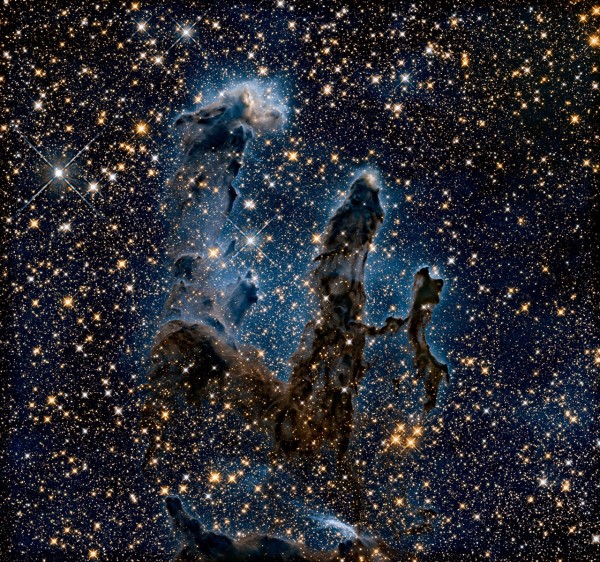 Image credit: NASA, ESA/Hubble and the Hubble Heritage Team; Acknowledgement: P. Scowen (Arizona State University, USA) and J. Hester (formerly of Arizona State University, USA).
Image credit: NASA, ESA/Hubble and the Hubble Heritage Team; Acknowledgement: P. Scowen (Arizona State University, USA) and J. Hester (formerly of Arizona State University, USA).
The pillars are still there, and supernovae won't blast them apart; they will evaporate slowly over a few hundred thousand years, a much longer timescale than initial estimates pointed to. Thanks to twenty years of data, we can know this for sure. The math and techniques have not advanced much, surprisingly; the biggest advances have come in camera technology. It's the Hubble servicing missions that have kept Hubble so up-to-date. Remember, it's had the same mirror and light-gathering power for all 25 years, it's just what's been added to it has really maximized what we can learn from each and every photon.
From William Hendrixson on the number of planets in our galaxy: "So our detection is biased towards certain conditions, that makes perfect sense, but is rocky planetary formation biased towards certain types or ages of stars? Are we indiscriminate at which stars we look at or selective?"
We look at things in our neck of the woods, because that's what we can see. We measure a wide variety of stars, and most of what we measure are M-class stars: red dwarfs, simply because they're the most common.
There are some stars older than the Sun, and some that are metal-poor by comparison. But not by a whole lot; most are more Sun-like than you might think, having formed within just a few billion years of our own star. So what we see is a lot of stuff that looks a lot like we do. If we were looking at globular clusters or at the very outskirts of the galaxy, we might find fewer planets, but what we see by us is turning out to be quite similar to what we are.
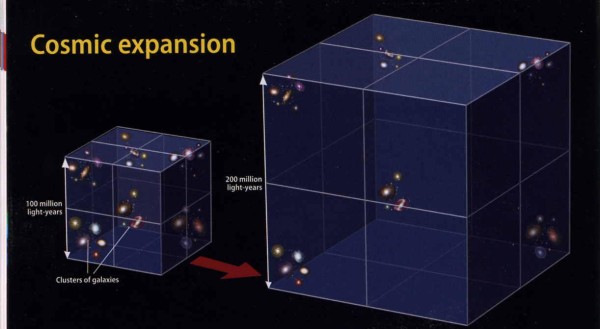 Image credit: Astronomy Magazine, 2007, via http://home.earthlink.net/~rarydin/hot%20stuff.htm.
Image credit: Astronomy Magazine, 2007, via http://home.earthlink.net/~rarydin/hot%20stuff.htm.
From alex on the status of the Universe: "When you say that the visible horizon is 40 bn l/y away does that really mean that the most distant galaxies are 40 bn l/y away as of now but the light from them that we get could travel no more than 13 bn years (the age of the Universe)? That means they drifted away with the speed exceeding the speed of light (40 – 13 > 13)? How is that possible?"
This will take a full article to answer. Here you go.
From cosmonut: "You say: 'We’re restricted to the part we can see, but what we can determine is that if the Universe is curved, the amount of curvature is no more than 0.25%. (New constraint from Planck 2015!)'
1. Would you have a reference for this, please ?
2. If space was shaped like a 3D hypershere, would curvature of 0.25% mean that the radius of the sphere was at least 400 times ( = 1/0.0025) times the radius of observable universe ?"
Yes to both. The reference was Martin White's plenary talk at the AAS meeting on Wednesday, where he talked about the Planck results that have not yet been published. The paper should be out, as he said, "in a few weeks," so I'm betting March. The previous best constraint on spatial curvature was 0.4% from WMAP, so this is nearly a factor of two improvement.
As for your hypersphere question?
Unfortunately, as you can see from the surface of a 2D sphere, the curvature increases the farther away you go. What we can say, based on a curvature of 0.25%, is that the radius of curvature can be no smaller than 16c/H_0, which corresponds to -- in units you are familiar with -- about 695 billion light-years in radius.
Still big, but not as big as you were hoping.
And those are the best comments (according to me) from this week; thanks for all your engagement and looking forward to another great one!


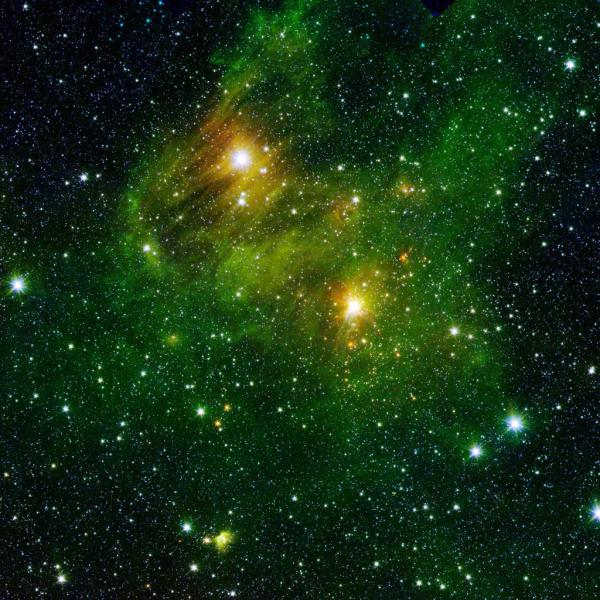
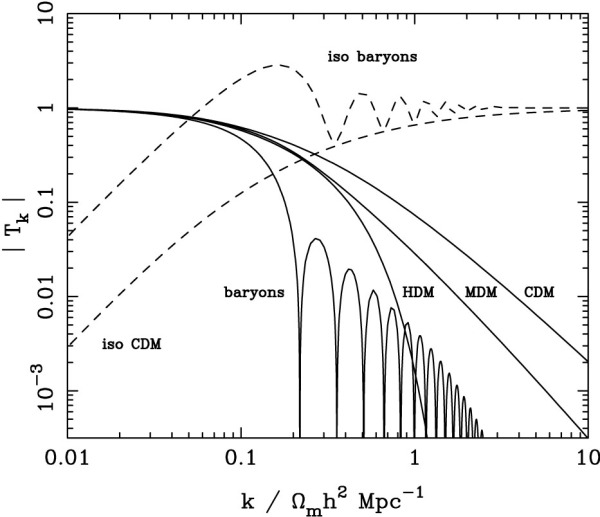
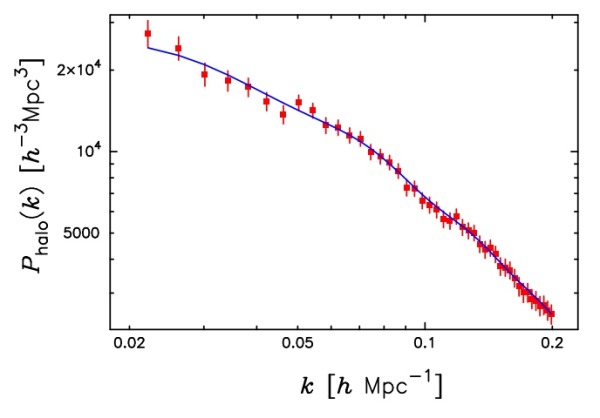


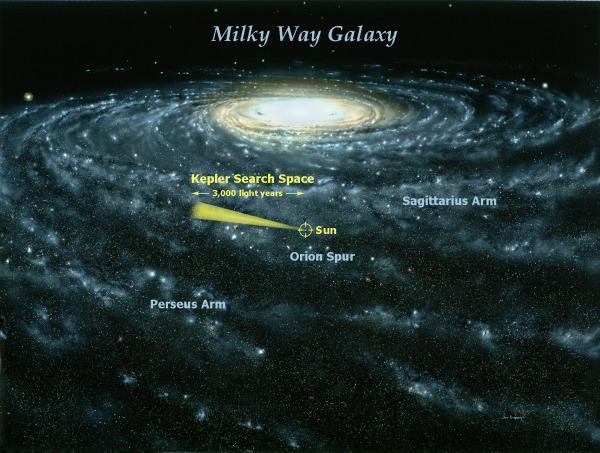
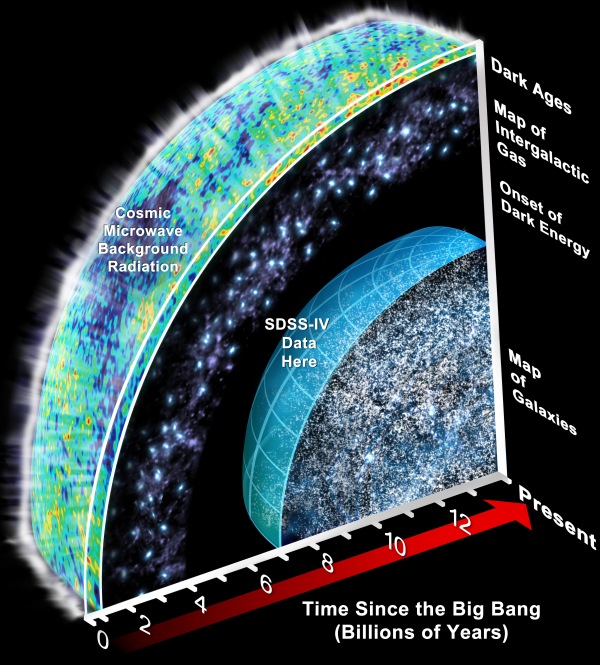
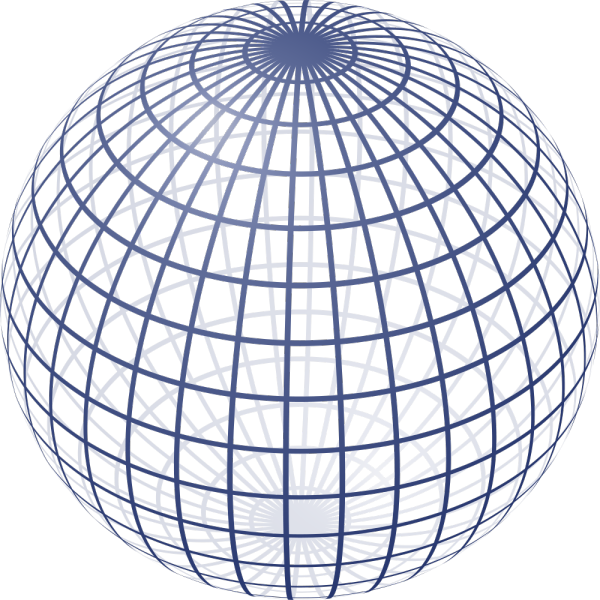
expansion of this universe...It's my view expansion is not possible, without first to increase matter I.e. energy contained within the universe, by conversion of gravity into dark energy /dark matter.this cannot be possible.What is possible is an external force exterior to the universe,if this is so,it's time that is changing.A measurement of distance remains Constant but not time...Jacktar ..
When the Hubble space telescope was first proposed, its stated goal (and why it was named the Hubble telescope in the first place) was to measure the expansion rate of the Universe: the Hubble parameter.
What?
^ Blockquote fail, I take it, is obvious.
There were three Key Projects. The Extragalactic Distance Scale dates to 1984, seven years after the Space Telescope was funded.
Hi Ethan thank you for answering my question about dark maters role in the early formation of the universe.
I was wondering in a historical sense was dark matter ever proposed before people like Vera Rubin etc measured its effects,or does it take modern computers to show that using quantum theory is not sufficient to form the structures we see in the universe today?